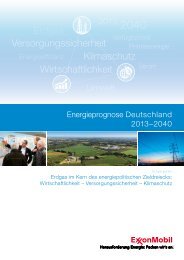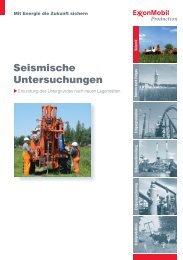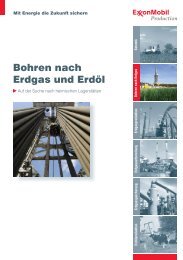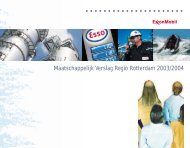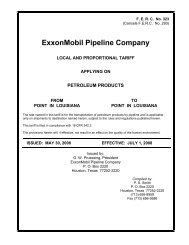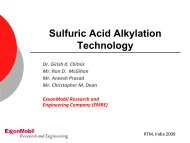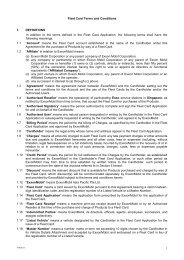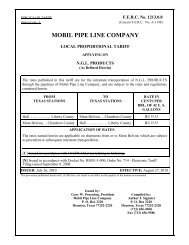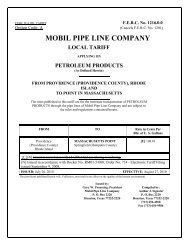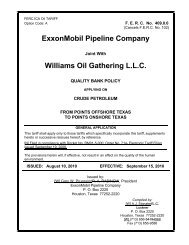A Winning Synergy - ExxonMobil
A Winning Synergy - ExxonMobil
A Winning Synergy - ExxonMobil
You also want an ePaper? Increase the reach of your titles
YUMPU automatically turns print PDFs into web optimized ePapers that Google loves.
Crude Oil<br />
Condensate<br />
Overview:<br />
Singapore Refinery Process Overview<br />
Resid<br />
Fuels<br />
Lubes<br />
Naphtha<br />
Mogas<br />
Kero<br />
LPG<br />
Solvents<br />
Diesel<br />
Heavy Gas Oil<br />
Fuel Oil<br />
GP I Lubes<br />
GP II Lubes<br />
Asphalt / Wax<br />
Fuel Oil<br />
The refinery converts the raw material - either<br />
crude oil or condensate into:<br />
a) Finished products that are marketed through<br />
the supply chain e.g. LPG, motor gasoline,<br />
jet fuel, diesel fuel, lubricating oils, bunker fuel<br />
and asphalt.<br />
b) Intermediate / by-products that are consumed<br />
internally as chemical feedstock or fuel e.g.<br />
fuel gas, hydrogen, naphtha, reformate,<br />
distillates and fuel oil.<br />
These raw materials are transformed into<br />
products through a number of unit operations<br />
e.g. fractionation, conversion, treating and<br />
blending.<br />
Naphtha<br />
• Fractionation (physical separation) is the<br />
separation of hydrocarbons in distillation towers<br />
into groups of hydrocarbon compounds of<br />
different boiling-point ranges called "fractions"<br />
or "cuts".<br />
Aromatics<br />
Steam Cracker<br />
Paraxylene<br />
Benzene<br />
Cyclohexane<br />
Orthoxylene<br />
Toluene<br />
Aromatics Solvents<br />
• Conversion (chemical reaction) changes the<br />
size and/or structure of the hydrocarbon<br />
molecules. Conversion may result in a<br />
decomposition, unification or isomerisation of<br />
the feed molecules.<br />
• Treating processes (physical separation and/or<br />
chemical reactions) prepare hydrocarbon<br />
streams for additional processing or finishing<br />
operations. It involves the removal or separation<br />
of impurities and other undesirable components.<br />
• Blending is the process of mixing and combining<br />
hydrocarbon fractions, additives and other<br />
components to produce finished products with<br />
specific performance properties.<br />
These processes are supported by other activities<br />
like oil movement, utility generation / distribution<br />
and effluent treatment.




